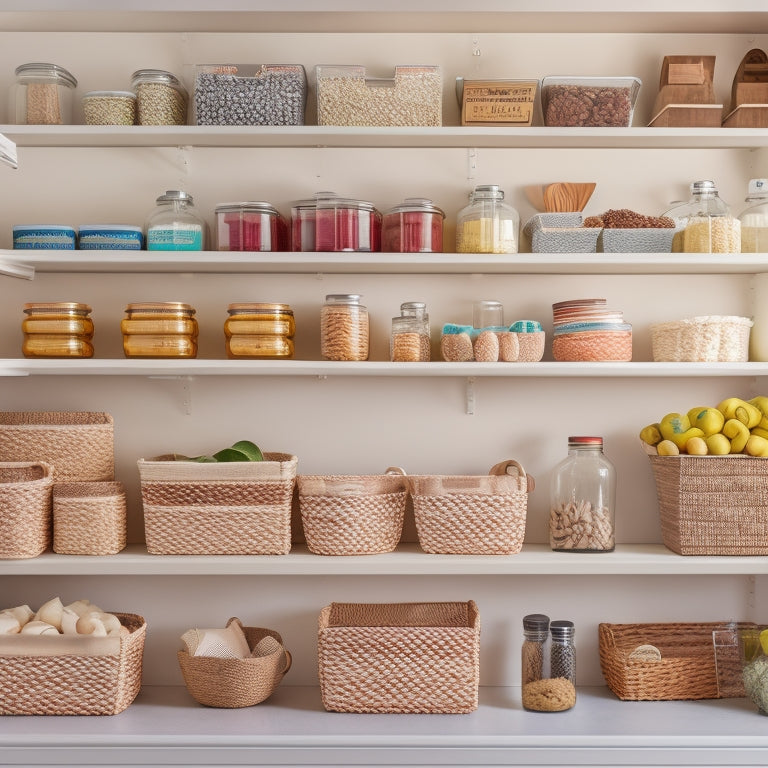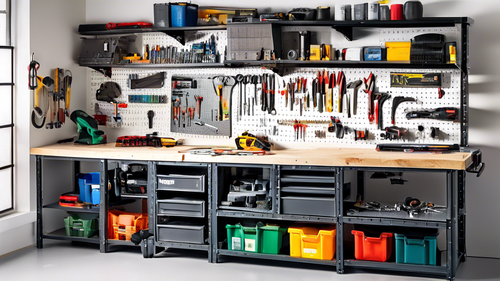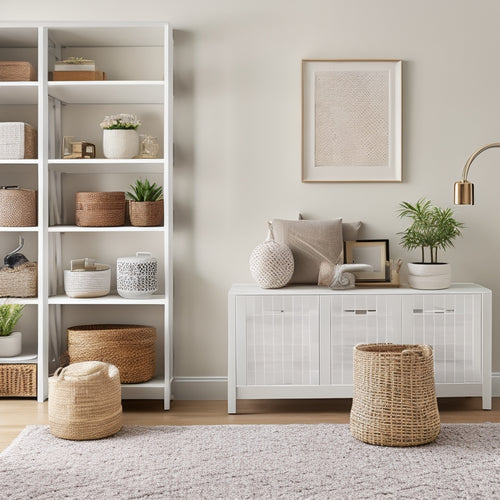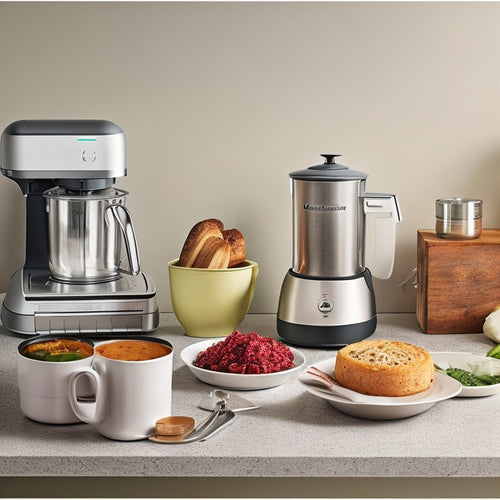
10 Ways to Optimize Your Kitchen Pantry Storage
Share
You can maximize your kitchen pantry's storage capacity by evaluating its space and needs, then purging and categorizing food items. Assign zones for easy access, and install adjustable shelving units to optimize the layout. Utilize vertical storage options, like wall-mounted baskets and hooks, to make the most of your space. Implement a 'first in, first out' system to maintain organization, and label storage areas for quick identification. Don't forget to maximize corner space efficiency and maintain your pantry's organization regularly. By following these tips, you'll be well on your way to a more efficient pantry - and there's even more you can do to take it to the next level.
Key Takeaways
• Assess pantry dimensions and existing storage solutions to customize the layout based on space and needs.
• Purge expired or unwanted items and categorize remaining food into groups for easier access and reduced clutter.
• Assign zones for daily essentials, baking supplies, snacks, and spices to optimize pantry layout for efficient meal prep.
• Install adjustable shelving units and utilize vertical storage options like wall-mounted baskets and hooks to maximize storage capacity.
• Label and sign storage areas with a color-coded system to ensure easy identification and maintain organization over time.
Assess Pantry Space and Needs
Take stock of your pantry's dimensions, shelving, and existing storage solutions to identify areas for improvement and define your storage needs. This pivotal step will help you evaluate space and determine how to maximize it.
Measure the width, depth, and height of your pantry, including any obstructions like pipes or electrical outlets. Note the type and number of shelves, as well as their adjustability. Assess the condition and functionality of your current storage solutions, such as baskets, bins, or containers.
Next, think about your storage needs. Consider the types and quantities of items you need to store, such as canned goods, dry goods, snacks, and cooking supplies. Do you need space for infrequently used items, like special occasion dishes or cookbooks? Do you prefer a specific layout or organizational system?
Answering these questions will help you customize your layout and create a functional storage plan. By taking the time to evaluate your space and needs, you'll be able to create a pantry that's tailored to your unique requirements, making meal prep and cooking more efficient and enjoyable.
Purge and Categorize Food Items
Begin by sorting through your pantry's contents, discarding expired, stale, or unwanted items to create a clean slate for your new storage system. Check expiration dates and toss anything past its prime. Consider donating unopened, non-perishable items to a local food bank or shelter. This purge will help you focus on what you really need to store.
Next, categorize your remaining food items into groups like baking supplies, snacks, canned goods, and breakfast items. This will make it easier to assign a home for each category in your pantry. Be efficient by grouping similar items together, making it simpler to find what you need when you need it.
For instance, store all your spices in one area, or designate a shelf for oils and vinegars. By categorizing your food items, you'll be able to see what you have, reduce clutter, and maintain a sense of control over your pantry's contents.
Assign Zones for Easy Access
Assign Zones for Easy Access
With your categorized food items in hand, designate specific zones within your pantry for each group, ensuring that frequently used items are placed in easy-to-reach locations. This zone organization will optimize your pantry layout, making meal prep a breeze. Consider the following zones:
| Zone | Description |
|---|---|
| Daily Essentials | Frequently used staples like pasta, rice, and canned goods |
| Baking Station | Baking supplies, including flour, sugar, and baking powder |
| Snack Central | Healthy snacks, nuts, and dried fruits |
| Spice Rack | Herbs, spices, and oils |
| Pantry Overflow | Infrequently used items, like special occasion foods or cooking supplies |
Install Adjustable Shelving Units
As you design your pantry layout, install adjustable shelving units that can be customized to fit your specific storage needs, allowing you to maximize vertical space and create a more efficient storage system.
This type of custom shelving enables you to tailor your pantry organization to your unique requirements, ensuring that everything has a designated place. Adjustable shelving units come in various materials, such as wood, metal, or a combination of both, and can be installed in a variety of configurations to suit your pantry's dimensions.
You can choose from different shelf depths, widths, and heights to accommodate items of different sizes. For instance, you can dedicate wider shelves to bulky items like canned goods or cookbooks, and narrower shelves to smaller items like spices or oils.
Utilize Vertical Storage Options
You can greatly enhance your pantry's storage capacity by incorporating vertical storage options, such as wall-mounted baskets, hooks, or shelves, that make the most of the often-wasted space between the ceiling and the top shelf. This will allow you to store more items without taking up valuable floor space.
Here are some vertical storage options to explore:
| Option | Description | Benefits |
|---|---|---|
| Hanging Hooks | Install hooks on the wall or back of a door to hang items like baskets, bags, or utensils. | Saves floor space, easy access |
| Over the Door Racks | Attach racks to the back of a door to store spices, oils, or cleaning supplies. | Maximizes door space, easy to install |
| Vertical Dividers | Use dividers to separate items on shelves, keeping them organized and easy to find. | Reduces clutter, increases visibility |
Incorporate Baskets and Containers
Incorporate baskets and containers into your pantry storage strategy to create a more organized and visually appealing space. By using baskets and bins, you can categorize and store items like snacks, spices, and baking supplies, keeping them easily accessible and out of sight. This will help maintain a clutter-free pantry and reduce stress when searching for a specific item.
When selecting baskets and containers, consider the size and shape of the items you plan to store. Choose containers with labels or dividers to facilitate easy identification and retrieval. You can also use stackable bins to maximize vertical storage and keep similar items together. Don't forget to leave some empty space between containers to allow for easy removal and replacement.
Remember to maintain your container organization by regularly cleaning out expired or unused items and rearranging your baskets and bins as needed.
With a well-organized pantry, you'll be able to find what you need quickly, cook more efficiently, and enjoy a sense of control and power in your kitchen.
Implement a "First In, First Out" System
Establish a 'first in, first out' system by designating a specific shelf or bin for new items, ensuring that older products get consumed before they expire. This FIFO system benefits your pantry organization by reducing food waste and saving you money.
When you bring new items home, place them behind the older ones, so the older products are front and center. This way, you'll be more likely to use them before they expire.
To take your FIFO system to the next level, implement inventory tracking. Keep a list or use an app to log the items you store in your pantry, including their expiration dates. Regularly check your inventory to identify products that are nearing expiration and plan your meals around them. This will help you avoid last-minute takeout or food waste.
Maximize Corner Space Efficiency
When it comes to maximizing corner space efficiency, you'll want to focus on two key areas: corner shelf installations and optimizing dead corner space.
By addressing these often-wasted areas, you'll be able to reclaim valuable storage real estate and create a more functional pantry.
Corner Shelf Installations
You can reclaim up to 25% of your kitchen's hidden corner space by strategically installing corner shelves that wrap around the often-wasted area where two walls meet. This space-saving solution is a game-changer for kitchen organization, providing ample storage for cookbooks, spices, or infrequently used kitchen gadgets. Corner shelf benefits extend beyond mere storage, as they also create a visually appealing display area for decorative items or kitchenware.
To take your corner storage to the next level, consider creative corner storage ideas such as installing a lazy Susan or a carousel to maximize accessibility. Alternatively, you can opt for DIY corner shelves that fit your kitchen's unique dimensions and style. With a little creativity and planning, you can turn a previously underutilized area into a functional and stylish hub.
Optimize Dead Corner Space
Your kitchen's dead corner space can be a major storage roadblock, but with a few strategic tweaks, it can become a highly functional area that streamlines your cooking workflow. To optimize this space, consider installing corner shelving solutions that can hold baskets, bins, or cans. These solutions can be custom-made to fit your pantry's dimensions, ensuring maximum storage capacity.
For hidden storage options, look into slide-out drawers, lazy susans, or carousels that can be tucked away in the corner. These clever corner layouts will keep your kitchen essentials within easy reach while keeping the area clutter-free.
To take your pantry corner hacks to the next level, think creatively about the layout. For instance, you can install a pegboard on the back of a door or a wall-mounted spice rack to maximize vertical storage. You can also use stackable containers or bins with labels to keep similar items organized.
Label and Sign Storage Areas
By designating specific zones for different categories of items, labeling and signing storage areas helps maintain a sense of order and makes it easier to locate what you need at a glance.
You can create a color-coded system to categorize items, such as using red labels for baking supplies, green for snacks, and blue for cooking essentials. This visual organization will help you quickly identify where items are stored.
To take it a step further, create DIY labels or markings that are clear and concise. You can use stickers, chalkboard labels, or even a label maker to create custom labels. Consider adding a brief description or icon to each label to make it easy to understand what's stored in each area. For example, you could add a picture of a coffee cup next to the label 'Coffee and Tea' or a picture of a spice jar next to the label 'Spices.'
Maintain Pantry Organization Regularly
Regular pantry upkeep is important to prevent clutter from accumulating again and to guarantee that your organized space remains functional and efficient over time. By incorporating regular maintenance into your routine, you'll guarantee your pantry organization stays on track.
Set aside time each week to tidy up your pantry, checking expiration dates, and removing expired or spoiled items. This will guarantee clutter from accumulating and make it easier to find what you need when you need it.
To maintain your pantry's organization, implement decluttering tips like the 'first in, first out' rule, where you use the oldest items before opening new ones. Also, consider implementing a 'one in, one out' policy, where you get rid of an old item every time you bring a new one into your pantry. By doing so, you'll maintain a balanced storage solution and guarantee clutter from accumulating again.
Frequently Asked Questions
How Can I Prevent Pests From Infesting My Pantry Storage?
You'll prevent pests from infesting your pantry storage by sealing containers tightly, keeping them off the floor, and maintaining organization; also, regularly clean up crumbs, and consider natural pest control methods like bay leaves or cinnamon sticks.
Can I Store Flammable Items Like Candles in My Pantry?
You shouldn't store flammable items like candles in your pantry, as it's a fire hazard; instead, consider proper storage in a well-ventilated area, away from heat sources, and implement essential safety measures to prevent accidents.
How Often Should I Clean My Pantry Shelves and Containers?
"I know, you're busy, but trust me, you can spare 10 minutes a week to maintain your pantry organization. Create a cleaning schedule to dust shelves and wipe down containers every Sunday, and deep clean every 3 months to keep your pantry organized and pest-free."
Are There Any Specific Pantry Storage Options for Small Kitchens?
You're dealing with a small kitchen, so you need space-saving solutions like custom shelving, drawer organizers, and over-the-door racks to maximize storage and keep your pantry organized, making the most of every inch.
Can I Use My Pantry for Storing Non-Food Items Like Cookbooks?
"In medieval times, castles had libraries; why not you? You're a master of kitchen organization, so repurpose your pantry to store cookbooks, adding a touch of home decor flair, and reign supreme over your culinary domain."
Related Posts
-

Garage Workbench Organization
Garage Workbench Organization: A Guide to Maximizing Space and Efficiency Are you tired of a cluttered and unorgan...
-

Taming the Chaos: 10 Home Storage Hacks
You're tired of living in a cluttered space, where chaos reigns supreme. To tame the mess, start by decluttering with...
-

What Are the Best Compact Smart Kitchen Appliances?
When it comes to compact smart kitchen appliances, you'll want to prioritize energy efficiency, space-saving design, ...


